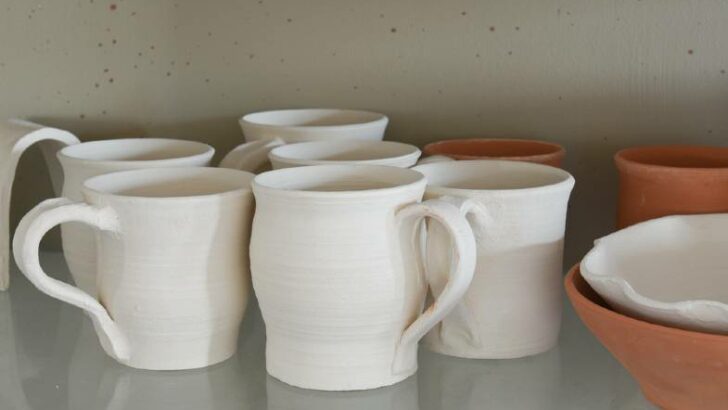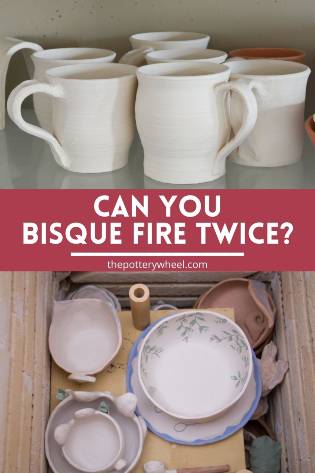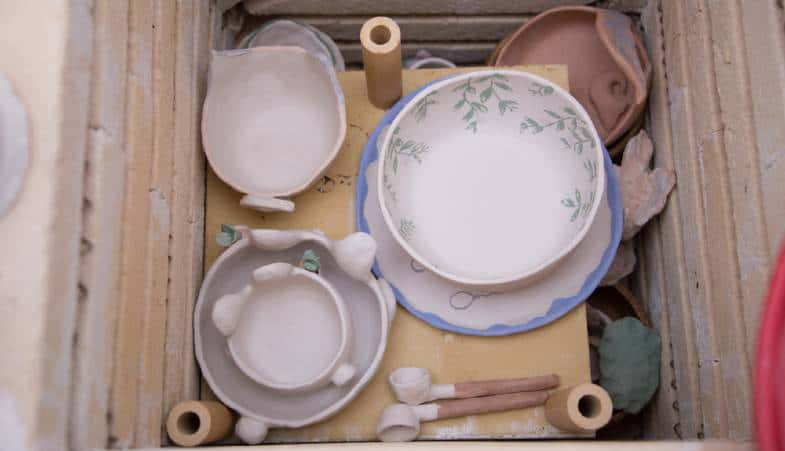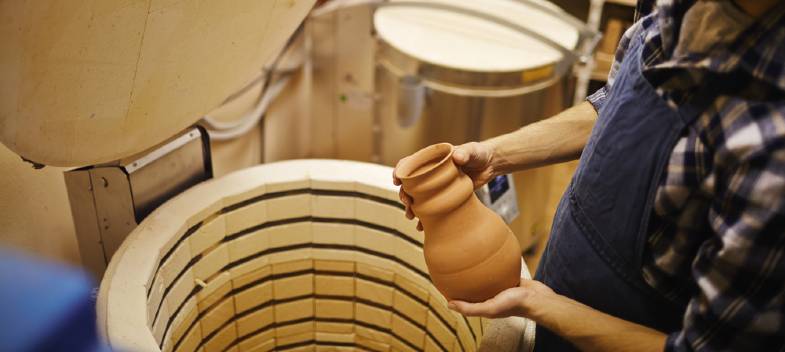Your cart is currently empty!
Can You Bisque Fire Twice? – Will Your Pots Survive?
Published:
Last Updated:

Affiliate Disclaimer
As an affiliate, we may earn a commission from qualifying purchases. We get commissions for purchases made through links on this website from Amazon and other third parties.
Recently, I wanted to create a layering effect with underglaze, using masking tape. I was worried that the masking tape would pull off the unfired underglaze. And, I found myself wondering ‘can you bisque fire twice?’. So, I did a bit of research and this is what I found out.
You can bisque fire twice without damaging your ceramics. Bisque firing more than once is quite common practice, particularly if you want to seal underglaze before glazing. There are certain decorative techniques, such as using china paint, that involve firing at lower temperatures multiple times.

Why Might You Bisque Fire Twice?
There are a few reasons why you might want to bisque fire twice. Some of these reasons are as follows…
To Prevent Underglaze Smudging
Unfired underglaze has a slightly powdery finish and this can become streaky when you apply glaze on top of it.
Streaky underglaze is more likely to happen when you apply your glaze using a brush. As you draw your brush across the underglazed surface, the glaze can drag the underglaze along with it.
One solution is to apply the underglaze to your greenware and then fire your pottery. Then when you apply your glaze, you are applying it to fired underglaze.
However, personally, I prefer to apply underglaze to bisqueware. I find it easier to gauge what the fired underglaze will look like when it’s applied to bisque. The colors of the underglaze seem to be closer to their fired color when applied to bisque.
You can also reduce underglaze streaking by dipping your pottery into glaze rather than brushing. However, not everybody has access to dipping glazes. Brushing glaze is more convenient if you are making your pottery at home. Large buckets of dipping glaze are not easy to store if space is at a premium.
Therefore, sometimes, bisque firing twice to seal the underglaze decoration is your best option.

Layering Underglaze
Normally you don’t have to bisque fire twice to layer underglaze. Underglaze is designed to be layered up without difficulty by simply letting it dry between coats.
However, there may be an occasion where you want to mask off sections of your underglaze using masking tape.
For example, if you want to apply a different color of underglaze with a precise line and a stenciled design. Or maybe you want to glaze one section of your pottery, and want a precise edge to the glaze layer.
One way to do this is to mask off a section of the existing underglaze design using masking tape. However, if your underglaze is unfired, even low tac masking tape might pull the underglaze off when it’s removed.
A solution to this is to bisque fire twice so the underglaze is firmly bonded to the ceramic. Then you can use masking tape or a low tac stencil without damaging the underglaze design.
Correcting Problems in the First Bisque Fire
Most potter’s bisque fire at cone 06 or 04, which is between 1830-1940F (999-1060C). Some clay bodies are best suited to being fired at 06. And some are better suited to being bisque fired at 04.
During a bisque fire, organic and carbonaceous material is burned from the clay. If this matter isn’t burned off during the bisque fire it can cause glaze imperfections later on.
If organic matter and carbons continue to burn out during a glaze fire, they create gases that can ruin glaze. Glaze imperfections such as pinholing are caused when gases escape from ceramics during a glaze fire.
Sometimes things can go wrong with a bisque fire and the ideal bisque temperature is not reached. This can be due to human error or the kiln not working as it should.
Human Error
It may be that you normally bisque fire your pottery to cone 04, and mistakenly fire to 06. If this is the case, it’s fine to bisque fire again to the right temperature.
Technical Problems
Sometimes kilns are not functioning at their optimum. For example, an element in the kiln might stop working. This can lead to a cool spot in the kiln or to the overall temperature in the kiln not being high enough.
If this is the case, then your ceramics will not have received sufficient heatwork and will probably be underfired.
Under such circumstances, it’s best to bisque fire twice, to make sure your ceramics are ready to be glaze fired.

At What Temperature Should You Bisque Fire Twice?
The temperature to bisque fire twice depends on what you want to achieve.
Sealing Underglaze
As stated above, one of the reasons you may want to bisque fire twice is to seal your underglaze decorations. You don’t need to bisque fire all the way up to cone 06 to do this. Most underglaze will have hardened around cone 010 (1629F / 887C).
At cone 010, the underglaze may still be quite powdery. But it will be more stable and tougher than in its unfired state.
Glaze imperfections
If you get glaze imperfections when bisque firing to cone 06, you may want to try bisque firing to 04. Some potters find that this eliminates problems with pin holing and bloating during the glaze fire.
Let’s say you have a kiln load of pottery that’s been bisque fired to 06. If you glaze fire some pieces and you aren’t happy with the results. You can bisque fire the remainder of the load again at 04 and see if that improves the glaze outcome.
If you would like to know more about re-firing underfired glaze, check out my article on exactly that subject here.
When Can Firing Multiple Times Cause Problems?
If you over fire clay beyond the temperature at which it matures, at best it will become brittle. At worst, it will warp, bloat, or melt.
You can refire at glaze temperatures. However, refiring at high temperatures can make pottery more brittle. And most clay bodies do have a limit to the number of times they can be refired at higher temperatures.
However, at lower temperatures, multiple firings are normally fine. In fact, some decorative techniques such as using china paints require multiple firings at bisque temperatures.
China paints are applied to glazed pottery and are therefore also known as overglaze enamels. Like underglazes, they require the application of a few layers to build up the color and intensity. However, unlike underglaze, china paints need to be fired between the application of layers.
China paints are normally fired at lower temperatures of around 016 (1458F / 792C) to mature each layer. So, ceramics decorated in this way is often fired multiple times in the lower temperature range.
Final Thoughts
It’s generally fine to bisque fire twice. In fact, provided you are not firing beyond cone 04, it would be ok to bisque fire more than twice. If you bisque at temperatures higher than cone 04, you will have problems applying your glaze successfully. However, provided you stay within the bisque temperature range you can bisque fire twice or more without problems.



